info@skyfallmeteorites.com
A Personal Interview
In Sept. 2014, Paul Harris of Meteorite Times published an article about me. The answers I provided back then still resonate with me, but I wanted to bring some of them up to date so you could get a better idea of who I am.
How did you get interested in meteorites?
As described on our SkyFall History page, I will be forever grateful to the Meteorite Men for bringing me into this hobby turned obsession. I was channel surfing one day and stumbled onto a typical episode where Geoff and Steve were globetrotting and having a blast hunting these elusive rocks from space. Needless to say, it only took one episode and I was hooked.
What was your first meteorite and when did you get it? Do you still have them?
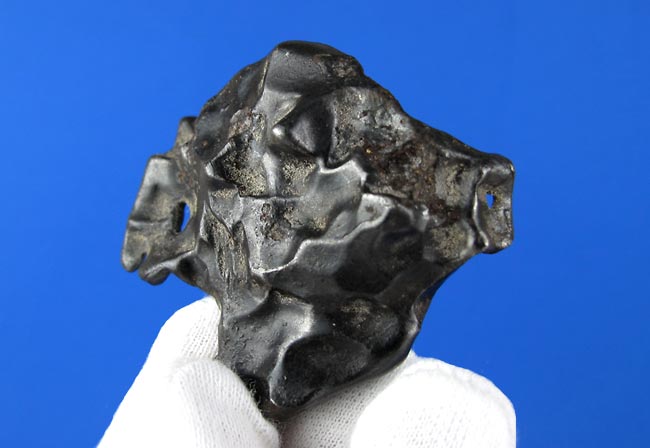
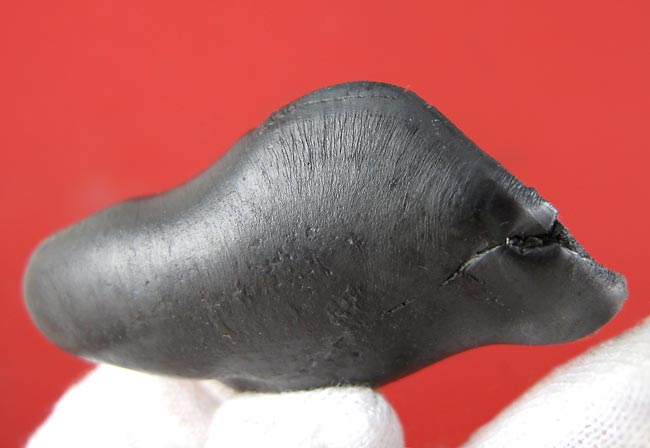
I bought two meteorites from Geoff Notkin of Aerolite Meteorites on Oct. 25, 2011, and both were Sikhote Alins. One was an oriented shield with a complete rollover lip (http://bit.ly/1mYu4c8) and the other an individual with two holes that Geoff had named “The Mask” (http://bit.ly/1zSlot3).
Yes, I still have both pieces and still enjoy them.
Do you have special areas of interest that you focus on in regards to meteorites (thin sections, photography, their chemistry, etc.)?
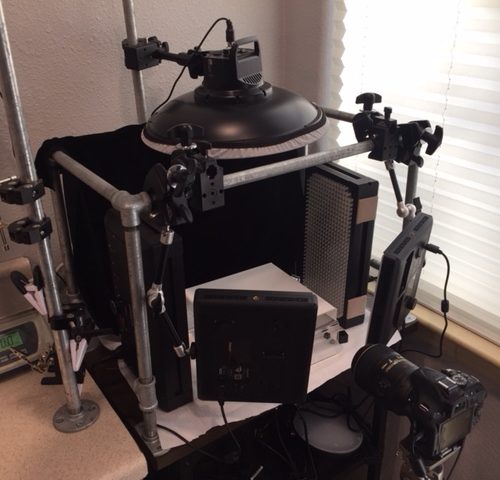
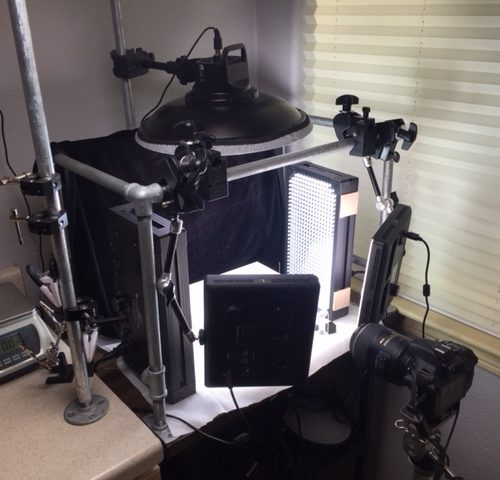
As my collection grew, I tried taking pictures to post on Facebook and eBay, and was always dissatisfied with the results. Prior to 2013, I knew next to nothing about photography, much less about macro photography, so I decided to teach myself. I had many failed experiments, but eventually my results improved. However, it was not until I designed my first and second custom light box that I finally got the results I was really looking for. As a recovering perfectionist, I’ll probably never be “done” with optimizing, but I now feel that when someone sees pictures of my specimens, it is pretty close to what it will look like in their hands.
I love to learn about meteorites. I am an avid reader and continually try to increase my knowledge and understanding. One of the joys about collecting meteorites is learning about where they came from and how their formation history. And, as a bonus, I finally get to make use of the AP Chemistry classes I took in high school. I also have a passion for helping and teaching others and do my best to help our small community grow in whatever ways I can.
Does your Family share in your interest in meteorites?
My family shares an interest, just not my obsession. I have some of my big irons displayed on the coffee table in the living room and my wife, Crystal, has grown very fond of the 13 kg Canyon Diablo we have. She has not named it yet, but it is clearly a part of the family. The CD has special meaning to her because even before I became involved with collecting meteorites, she had visited the Barringer Meteor Crater and was awed by its size and stark beauty. My son, Jacob, thinks meteorites are pretty cool; however, unlike his parents, he is not a collector at heart.
Do you have any special approaches to collecting? (Type collection, by aesthetics, historical specimens, etc.)
As a collector of other “things” in the past, I realized I had to have a strategy to start my collection. I started out with the idea to build a type collection. However, I kept being drawn to specimens that fell into four basic categories:
- Sculptural irons or specimens that are especially aesthetic
- Specimens with unusual features (e.g. exceptionally large chondrules and weird inclusions)
- Rare specimens (e.g. low TKW of an unusual type)
- Historical falls especially with old specimen cards or museum provenance.
As all collections mature, they evolve and transform in different and unexpected directions. My collection has been no different and I’ve decided to simply enjoy the journey, since choosing a destination implies an end to the road.
Do you mind saying how many locations your collection represents?
I do not collect locations per se, though I certainly understand the allure. I tried for a very short amount of time to collect all the Texas meteorites, but one can only have so many olivine-bronzites in their collection. My favorite location will always be Antarctica and am happy to have nice specimens of Thiel Mountains and ALH 76001 that are part of my permanent collection … unless I can find even bigger and better pieces.
Is your collection displayed, stored away, or both? If stored, do you use any special storage techniques?
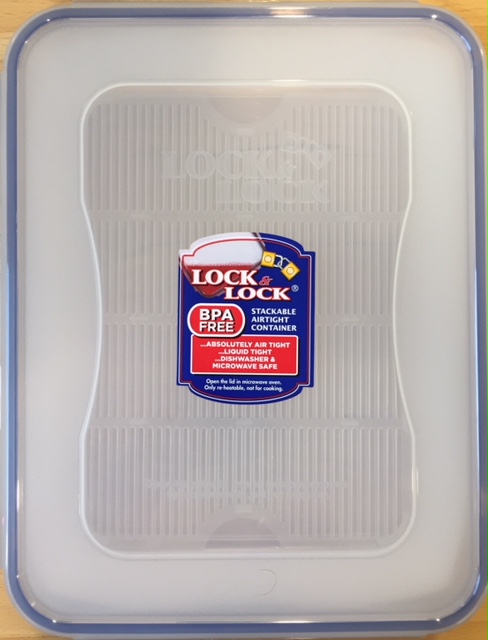
Different meteorites require different display and storage solutions. I do display some specimens in the living room and my office, but displaying all of them is neither practical nor wise due to their susceptibility to our unfriendly atmosphere. I initially stored my specimens in the acrylic display boxes with desiccant inside in the same way as many European dealers. However, this solution became unwieldy when I had to change out desiccant in hundreds of boxes. I have now moved to storing specimens in standard baggies, making sure the specimen card is stored in its own separate baggie, and then placing the specimens in airtight storage containers with desiccant beads at the bottom.
Protection and proper curation of meteorites are crucial to maintaining a collection. Unfortunately, I think some new collectors are not aware of these requirements and are rightfully disappointed when their specimens deteriorate. Different measures are required depending on the climate in one’s area, but I treat all my meteorites as if they were going to spend the rest of their existence in Hawaii, for example. As described earlier, I try to reduce exposure to the outside world as much as possible and use desiccant liberally.
As collectors, we spend hundreds to thousands of dollars on our specimens and ensuring their long-term stability is key to enjoying them. You can read more about proper storage of meteorite specimens.
In what ways do you use your computer for meteorites? (met-list, social media, meteorite research, shopping, etc.)
The computer is indispensable for me and use it for all the activities listed above. However, the one activity I never anticipated was how it would enable me to establish exceptional friendships and relationships with people all around the world – most of whom I have never met in person. Luckily, I do travel often as part of my professional career, and have made it my mission to meet in person as many of my virtual friends as possible.
Do you ever hunt for meteorites?
I do and I love doing so for what would appear to be contradictory reasons. I love the solitude and the camaraderie, as well as the long quiet moments occasionally interrupted by the thrill of the find. I think many meteorite enthusiasts are adventurers and explorers at heart and, anytime we can get the chance to go on a hunt, we do so.
An important aspect of hunting meteorites is appreciating how terribly hard they are to find. I hunted for Holbrook, Sutter’s Mill, Novato, Franconia, Mt. Blanco and on various California dry lakes, and the one thing they have in common is that there is never a guarantee of making a find. If you are out there to make money, and some are quite successful doing so, realize that hunting meteorites can easily be a money-losing proposition. I enjoy the hunt for the sake of the hunt and am therefore never disappointed. For example, the results of an entire week of hunting different locations around Franconia … 0.6g of SAW 005 iron and I was thrilled.
What is your favorite meteorite in your collection?
That question is like asking what my favorite food is. How do you choose among so many worthy candidates when it comes to meteorites? Well, like choosing my favorite food, it depends on my mood and circumstances. Planetaries are great because I enjoy watching people’s reactions when I put a piece of the moon in one of their hands and a piece of Mars in the other.
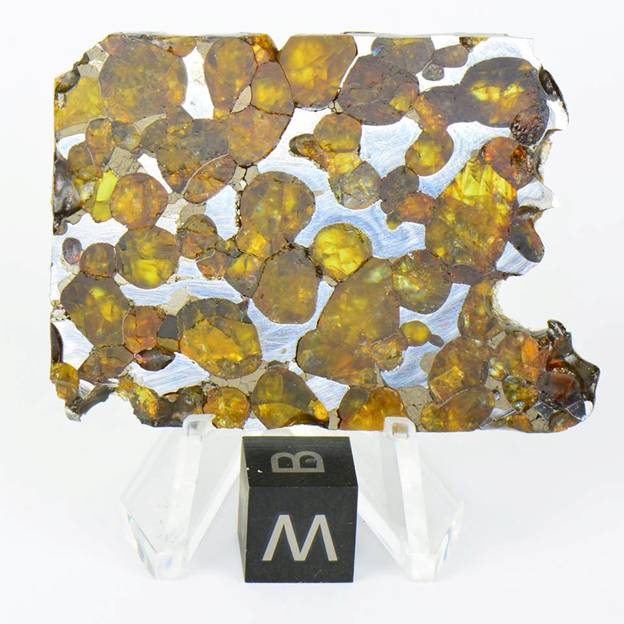
I was fortunate to be able to buy a large percentage of Ron Hartman’s collection and he clearly had his favorites as well. I really wish I could have met him as our collecting styles were so similar and based on all I have heard, he was such a gentleman. So, one of my favorite meteorites is a slice of the Antarctic pallasite, Thiel Mountains, that he made part of his “Ron Hartman Collection” pieces.
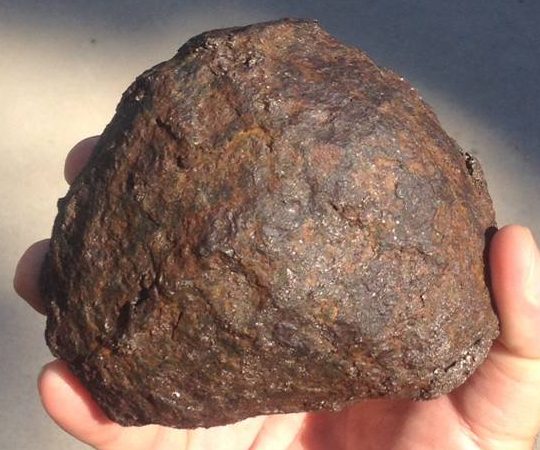
In one of the first trades that I did, I was able to get a 500g+ slice of THE Bondoc pyroxenite nodule from ASU. There is only one other slice in private hands and though Bondoc is plentiful, there is precious little of the pyroxenite nodule to go around. There is an interesting paper written about this nodule that can be found at http://www.lpi.usra.edu/meetings/lpsc2010/pdf/1386.pdf. That interaction led to my being able to acquire the 2nd largest Bondoc iron nodule weighing in at 2.6kg. And before anyone says anything, this nodule has been stable since I acquired it.
Then again, how could I forget finding my 1.6g of Sutter’s Mill – that was an experience I will never forget and one that allowed me to meet so many of the people that have helped influence and shape my collection as well as become friends.
What is your favorite overall if it is not the one above?
The next one I acquire for my collection – that is the curse of the collector!
What makes these of special interest?
The thrill of the hunt whether on eBay, ferreting out an old collection or finding it in the field. As a collector, there are few things more gratifying than making that next acquisition, especially if it was tough to get.
What meteorites are currently on your wish list?
My original list from 2014 included Ibitira, Sera de Mage, Pasamonte, Puerto Lapice, a large uncleaned Sikhote Alin with great crust and Russian museum label, a really sculptural Gibeon, a large oriented NWA with deep fluting and a good crust, and any meteorite that allows me to make new friends and ponder my place in the universe. I have been fortunate to be able to acquire Ibitira and Sera de Mage to my collection. I am still on the lookout for the previous remaining items and have added these to my list: Mighei, Paris, Ivuna, Rumuruti (I had but had to sell), Chassigny, Silacauga, Semarkona and basically every “Unobtainium” specimen you can imagine!
What methods have been most successful in building your collection? (Buying at shows, from dealers by mail, auctions on the web, trading, etc.)
First, as you may have guessed from my earlier responses, I put a great deal of importance on building relationships. Even in this day of computers, cell phones and Facebook – nothing beats a personal relationship based on mutual trust and respect. I strive towards effective and direct communications, and set clear expectations. Then, I keep my word. By creating these trusted relationships, dealers, collectors and friends will approach me with opportunities that were never public.
Second, and perhaps most importantly, the best way to build a collection is to be patient and to seize an opportunity when it arises whether it presents itself on eBay, auction houses, shows, Facebook, mailing lists, etc. As you can see from my list of desired specimens above, there is no single meteorite to complete my collection. Sometimes, meteorites come up for sale that I did not realize should be on my list. So, I carefully evaluate what I want for my collection and, either wait for the right deal to come up or work my network to see what is privately/publicly available.
Which shows do you attend?
I try to regularly attend the Tucson Gem and Mineral Show in late January/early February and the Ensisheim meteorite show in the Alsace region of France in June. I have attended the Denver show in the past, but the altitude and really dry air take their toll on me. To date, I attend these shows as a buyer and do not have a room or booth for selling unless I am able to share with another dealer. I’m hoping to sell at these shows eventually, but I really enjoy the running around and seeing everyone – being stuck in a booth or room is not for me (for now).
Do you also collect related materials like impact glasses, breccias, melts, tektites, shocked fossils, native iron rocks etc?
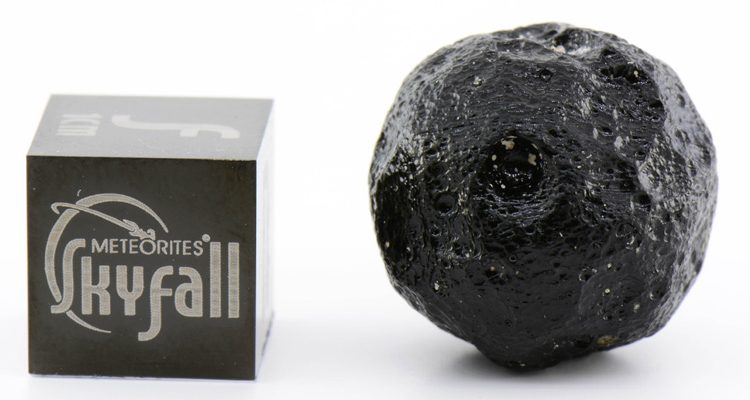
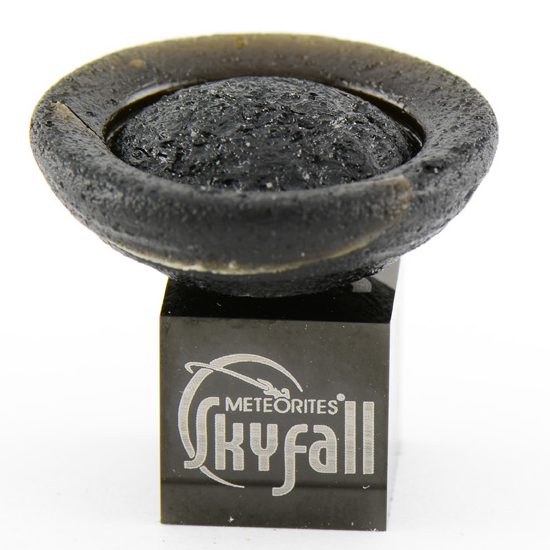
I did not plan to, but when I attended the Tuscon show in Feb. 2014, I purchased a perfect 4.55g Ivory Coast tektite from Alain Carion. When I hear the word “rare”, I can’t help but become interested and decided that was a worthy specimen to start my tektite collection.
I then followed up that purchase by adding 2 beautiful and fully flanged Australites to my collection one of which is shown here – again quality over quantity.
So, it looks like the tektite siren successfully lured me into that abyss – but I went willingly. I also now collect impact glasses like Darwin glass and when interesting specimens come up, I’ll even collect breccias. I am waiting to add a really large and finely featured shatter cone.
I also collect books and ephemera and have a full set of Nininger Stars and Barringer Crater Stock Certificates.
Do you prepare any of your own specimens? (cut, polish, etch, etc.)
I do prepare my own specimens including slicing meteorites, but my main focus for now is etching of irons. No surprise to anyone that even with the best curation and preservation techniques some irons will rust. So, when I started noticing some rust on specimens I had for a while, and bought specimens that needed to be re-etched, I decided to embark on that journey. I mean, how hard could it be? Well it is hard – very hard because the real art comes in not just the etching itself but making sure that the etch will remain bright and rust-free for a long time.
One of the clear artists in this area is Mirko Graul. His work is amazing and just as importantly, his etched irons tend to retain their shined and remain rust-free for years. He has clearly perfected his techniques over a long period of time. He keeps his trade-secrets very secret and rightfully so. After doing my own experimentation, and comparing etching results among many other dealers and preparers, I realized there is a big range in quality and long-term stability. So, if I was going to set a goal, that goal would be to become “almost” as good as Mirko – and other European masters. Through intensive research, experimentation and some private advice from some of my friends, I am making good progress and have achieved some beautiful results – but I still have a long way to go!
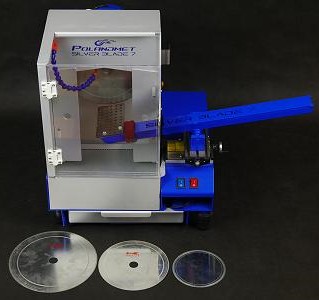
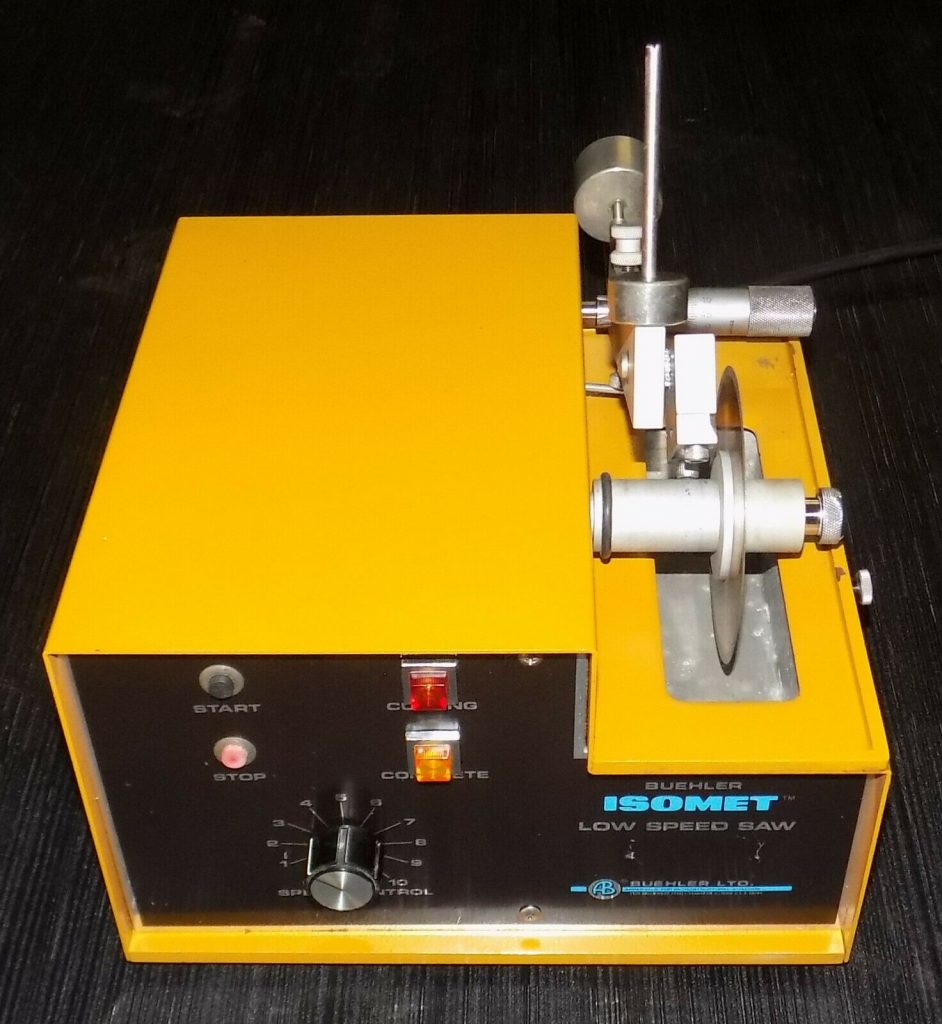
I have a Buehler Isomet saw that I use for basic slicing and I purchased a Silverblade saw from Marcin Cimala. Sometime soon, I hope to start slicing whole meteorites and that will open up a whole new world of challenges.
How have meteorites enriched your life?
There are people in our community that have taken the time and effort to mentor me. They have helped me understand meteorites and the business of meteorites. They have opened doors for me that would never have been available to me like a private tour of the Mona Kea observatory and seeing the non-public meteorite collections at the British Museum, the Vienna Museum of Natural History, the Vatican Observatory and many others. I am very happy to say that through meteorites I have made lifelong personal friendships with people in countries around the world like the England, Poland and Taiwan (and of course USA) that could never have happened outside of meteorites. There are still many incredibly cool people I have never met personally but hope to meet in the future.
Do you have any final thoughts?
As my interest in meteorites has grown, so has my desire to become more involved.
I spend a great deal of time managing my “Meteorites, Tektites, Impactites & Ephemera” Facebook group. I also created the FB group called “Meteorite or Meteorwrong?” that is well managed by Pat Brown. I encourage readers to “friend” me on Facebook where I post on many meteorite related subjects. You can check out my professional membership here.
I’ll sign off with the little sign that my son Jacob made for me:







